I decided to bike around Stokkavatnet via the Madlaruta. I actually consulted a map before leaving, which turned out to be an excellent idea. This route took me by where I will be working. It is maybe fifteen minutes away by bike- too close for any serious exercise. Then again, with this weather, it may be just far enough.
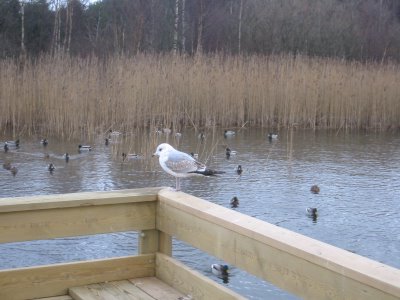 Stokkavatnet is a lake- not part of the ocean or a fjord.
Stokkavatnet is a lake- not part of the ocean or a fjord.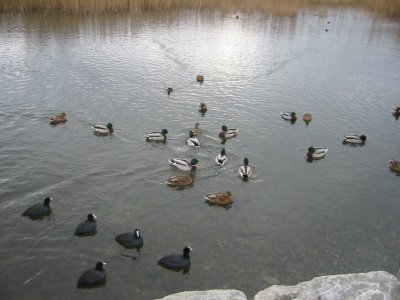 There were all sorts of ducks, including those odd black ones with white bills.
There were all sorts of ducks, including those odd black ones with white bills. I don't think there is any need for sunglasses in this part of the country- ever. I still haven't swapped out my lenses since we moved.
I don't think there is any need for sunglasses in this part of the country- ever. I still haven't swapped out my lenses since we moved.

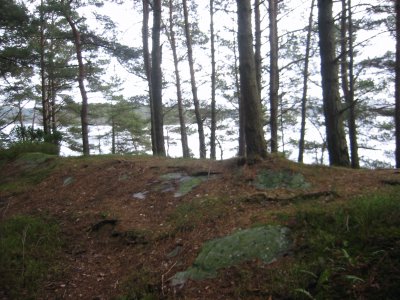
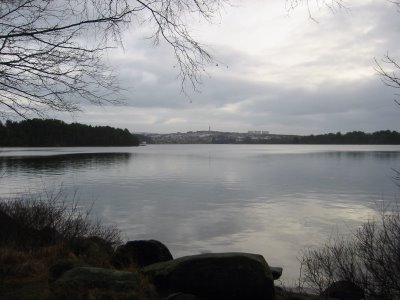 No matter where I go, the TV tower is always a landmark off in the dis
No matter where I go, the TV tower is always a landmark off in the dis

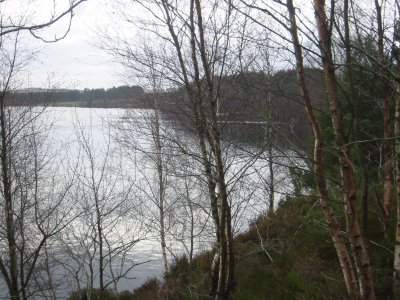



Here are a few photos from moving day- taken well before everything was moved in. They don't quite capture the reality we are living in at the moment.




5 comments:
Hey,
Have a great Xmas, Norwegian-style, your first in the new homeland. I wish you the best this holiday season.
40 degrees here in Mpls., and a spate of 3o degree days in the forecast; only in Minnesota, intolerable cold one day to balmy the next. Happy Holdiday.
Since you had some questions about Xmas I thought you might appreciate this info off the internet:
"Christmas is from the Old English words Cristes moesse, 'the mass or festival of Christ'. The first celebration took place in Rome about the middle of the fourth century. The exact date of the Nativity is not known, but even in pre-Christian times the period from December 25 to January 6 — now known as "The Twelve Days of Christmas" — was considered a special time of year. The abbreviation Xmas, thought as sacrilegious by some, is entirely appropriate. The letter X (chi) is the first letter in the Greek word for Christ.
Reindeer is actually redundant. The root rein is Scandinavian for 'reindeer', so reindeer translates to 'reindeer deer'. It came to English from Old Norse hreindyri.
Mistletoe is thought to be based on a German word for bird excrement (mix) from the fact that the plant is propagated in it, though there is also a theory that the term derived from another German word (mash) which refers to the stickiness of the berries. It is combined with an Old English word (toe) meaning 'twig'. This shrub usually grows on broad-leaved trees like apple, lime, and poplar.
Christmas carol is a term which originally referred to a non-religious ring dance accompanied by singing. Eventually it came to mean a merry song with a tune that could be danced to. The Italian friars who lived with St. Francis of Assisi were the first to compose these songs, c. 1410. Since the nineteenth century, carols have been sung in place of hymns in most churches on Christmas Eve and Christmas Day.
St. Nicholas was not only wealthy but modest, and he liked to help people in need without drawing attention to himself. Poor families would often find a gold piece or well-filled purse without knowing where it had come from. His American successor, Santa Claus, carried on the tradition.
Native to Central America, the red and green poinsettia has been a symbol of Christmas in the United States since the 1820s when it was first shipped to North America by Joel Poinsett, the American minister to Mexico.
Wassail comes from the Middle English waes haeil (c. 1205), which means 'be in good health' or 'be fortunate'. Wassailing was the Old English custom of toasting the holiday and each other's health. Wassail is also the name of the spiced apple beverage used in such toasting; it has been drunk since around 1300."
Happy Holidays from Dictionary.com!
Ah here's some more Xmas stuff addressing the reclamation project that Christianity began many years ago.
The Date of Christmas
The idea to celebrate Christmas on December 25 originated in the 4th century. The Catholic Church wanted to eclipse the festivities of a rival pagan religion that threatened Christianity's existence. The Romans celebrated the birthday of their sun god, Mithras during this time of year. Although it was not popular, or even proper, to celebrate people's birthdays in those times, church leaders decided that in order to compete with the pagan celebration they would themselves order a festival in celebration of the birth of Jesus Christ. Although the actual season of Jesus' birth is thought to be in the spring, the date of December 25 was chosen as the official birthday celebration as Christ's Mass so that it would compete head on with the rival pagan celebration. Christmas was slow to catch on in America. The early colonists considered it a pagan ritual. The celebration of Christmas was even banned by law in Massachusetts in colonial days.
Mistletoe and Holly
Two hundred years before the birth of Christ, the Druids used mistletoe to celebrate the coming of winter. They would gather this evergreen plant that is parasitic upon other trees and used it to decorate their homes. They believed the plant had special healing powers for everything from female infertility to poison ingestion. Scandinavians also thought of mistletoe as a plant of peace and harmony. They associated mistletoe with their goddess of love, Frigga. The custom of kissing under the mistletoe probably derived from this belief. The early church banned the use of mistletoe in Christmas celebrations because of its pagan origins. Instead, church fathers suggested the use of holly as an appropriate substitute for Christmas greenery.
Poinsettias
Poinsettias are native to Mexico. They were named after America's first ambassador to Mexico, Joel Poinsett. He brought the plants to America in 1828. The Mexicans in the eighteenth century thought the plants were symbolic of the Star of Bethlehem. Thus the Poinsettia became associated with the Christmas season. The actual flower of the poinsettia is small and yellow. But surrounding the flower are large, bright red leaves, often mistaken for petals.
The Christmas Tree
The Christmas Tree originated in Germany in the 16th century. It was common for the Germanic people to decorate fir trees, both inside and out, with roses, apples, and colored paper. It is believed that Martin Luther, the Protestant reformer, was the first to light a Christmas tree with candles. While coming home one dark winter's night near Christmas, he was struck with the beauty of the starlight shining through the branches of a small fir tree outside his home. He duplicated the starlight by using candles attached to the branches of his indoor Christmas tree. The Christmas tree was not widely used in Britain until the 19th century. It was brought to America by the Pennsylvania Germans in the 1820's.
Xmas
This abbreviation for Christmas is of Greek origin. The word for Christ in Greek is Xristos. During the 16th century, Europeans began using the first initial of Christ's name, "X" in place of the word Christ in Christmas as a shorthand form of the word. Although the early Christians understood that X stood for Christ's name, later Christians who did not understand the Greek language mistook "Xmas" as a sign of disrespect.
The Candy Cane
Candy canes have been around for centuries, but it wasn't until around 1900 that they were decorated with red stripes and bent into the shape of a cane. They were sometimes handed out during church services to keep the children quiet. One story (almost certainly false) that is often told about the origin of the candy cane is as follows:
In the late 1800's a candy maker in Indiana wanted to express the meaning of Christmas through a symbol made of candy. He came up with the idea of bending one of his white candy sticks into the shape of a Candy Cane. He incorporated several symbols of Christ's love and sacrifice through the Candy Cane. First, he used a plain white peppermint stick. The color white symbolizes the purity and sinless nature of Jesus. Next, he added three small stripes to symbolize the pain inflicted upon Jesus before His death on the cross. There are three of them to represent the Holy Trinity. He added a bold stripe to represent the blood Jesus shed for mankind. When looked at with the crook on top, it looks like a shepherd's staff because Jesus is the shepherd of man. If you turn it upside down, it becomes the letter J symbolizing the first letter in Jesus' name. The candy maker made these candy canes for Christmas, so everyone would remember what Christmas is all about.
Santa Claus
The original Santa Claus, St. Nicholas, was born in Turkey in the 4th century. He was very pious from an early age, devoting his life to Christianity. He became widely known for his generosity for the poor. But the Romans held him in contempt. He was imprisoned and tortured. But when Constantine became emperor of Rome, he allowed Nicholas to go free. Constantine became a Christian and convened the Council of Nicaea in 325. Nicholas was a delegate to the council. He is especially noted for his love of children and for his generosity. He is the patron saint of sailors, Sicily, Greece, and Russia. He is also, of course, the patron saint of children. The Dutch kept the legend of St. Nicholas alive. In 16th century Holland, Dutch children would place their wooden shoes by the hearth in hopes that they would be filled with a treat. The Dutch spelled St. Nicholas as Sint Nikolaas, which became corrupted to Sinterklaas, and finally, in Anglican, to Santa Claus. In 1822, Clement C. Moore composed his famous poem, "A Visit from St. Nick," which was later published as "The Night Before Christmas." Moore is credited with creating the modern image of Santa Claus as a jolly fat man in a red suit.
Copyright © 1997-1999 by Jerry Wilson; Get Permission to Reprint this article.
LA- I actually have been here twice for Christmas, and we are spending New Year's with three couples that are becoming our regular New Year's crew. New Year's eve is amazing here... everyone shoots off fireworks.
Christmas is a lot of strange food. More details to follow.
Don't forget to call Mom!!
Post a Comment